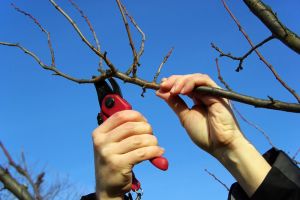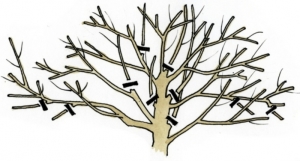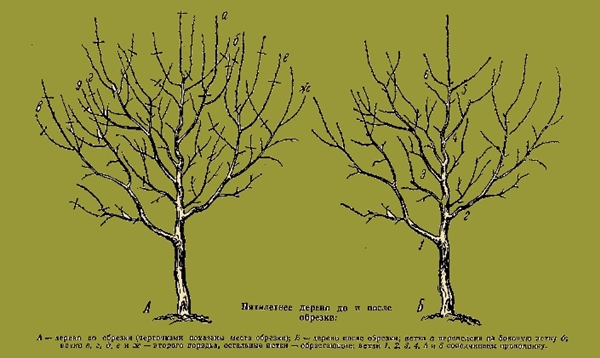Features of pruning cherries: technologies and rules
Cherry pruning is one of the most important tree care products. And nevertheless, many gardeners, fearing a significant decrease in fruit, do not dare to cut the branches. Others consider this a useless exercise, which, moreover, can weaken the tree and thereby cause irreparable harm to it. However, in reality, this is a consequence of not knowing how to prune cherries correctly, and making common mistakes as a result.
Meanwhile, the regular removal of unnecessary and unnecessary branches, thinning the crown has significant benefits. The yield increase increases several times, and the cherry berries become larger. The crown of the tree is correctly formed, without one-sidedness and thickening. The tree does not age longer and rejuvenates after such a procedure. In addition, timely pruning of sick and old cherry branches provides prophylaxis and additional protection from pests.
Content
Cutting technology
If the question arises of how to prune cherries correctly, it should be understood that this operation is carried out according to a clear scheme and is an important part of caring for the tree.
There are two ways to prune fruit trees: thinning and pruning. Pruning, or shortening, consists in partially removing the top of the branches, fruits and shoots. This method enhances the growth of young shoots, promotes thickening of the main branches and stimulates the rapid development of buds, which are located below the cut. Thinning or cutting is the removal of branches, fruits and shoots entirely. This pruning method allows you to improve the air-light regime, protecting the crown from excessive thickening, thereby strengthening the fruit formations.
After planting and the beginning of the development of the seedling, it is important to form a correct, symmetrical crown.It is advisable to prune annually.. Prune the tops of the tree so that it does not grow very high and does not grow to a huge size. The main feature of pruning cherries is that the buds of this tree are located at the tips of the branches, so it is better to cut the branch completely, rather than shorten it. Try to remove damaged, diseased or dead branches as soon as possible, this will provide good care and protection from diseases and pests. In addition, the cut sites should not be treated with special preparations, this will only slow down the recovery and healing process, which can subsequently harm the plant.

As a rule, you can prune cherries even in winter, but on condition that the temperature does not drop below -8 degrees. The cut points are sensitive to cold, therefore, this operation should not be carried out in severe frost.
Most often, pruning is carried out in early spring, when the juice has not yet begun to actively circulate. In the summer, such an operation is performed only when the tree is already well developed. Young seedlings will only suffer in this case, since the removal of branches with green leaves will deprive them of nutrients and strength. In the autumn period, such care is of a preventive and sanitary nature. By removing the unfruitful, old, diseased, dry branches, the tree gets rid of unnecessary load and prepares for winter. More specifically, you can check out the cherry trimming video attached below.
The difference in pruning between treelike and bushy
Bushy
Depending on the maximum size of an adult tree, fruiting and growth patterns, cherries are divided into two types: bushy and tree-like. Such varieties as Bolotovskaya, Fertile, Lyubskaya belong to bush. They usually bear fruit on annual shoots and form a small tree with low boles. The main task of pruning such cherries is to maintain vigorous shoot growth.
When the ends of the branches begin to bare on bush adult cherries, they are significantly shortened by a third of the length or even half of the shoot. Skeletal and semi-skeletal branches are shortened to lateral branches, which are well developed and grow upward, or to dormant buds. It should be borne in mind that pruning of skeletal branches is carried out in one year, and half-tree branches in another, thus, the tree adapts faster and gives a good harvest. Annual growths that appear as a result of such pruning should not be removed, since this cuts off the growth bud located at the end of the branch, and after fruiting, the shoot may die. Only shoots with a length of 45-55 cm are cut, which contributes to their branching later. Cutting is best done on a lateral branch rather than a ring.
With significant bare branches and attenuation of the growth of pagons, they are slightly rejuvenated, cutting off to a well-developed lateral branch, which is located on 3-4 year old wood. In case of emergency, rejuvenation is done deeper - for 4-6 years old wood, at the same time pruning the branches of second-order cherry trees.
Tree-like
Cherry varieties that form large enough mature trees are treelike. They bear fruit on bouquet twigs and annual shoots located on 3-6 year old wood.
Pruning a tree cherry is similar to pruning a bush, however, in addition to thinning the crown of young trees in the garden, shortening is used in order to remove forks, strengthen fruit twigs and subordinate branches. Only long shoots should be shortened, but short ones should be left without cutting.
When the annual growth is 15 cm or more, and the bases of skeletal branches are bare, rejuvenating pruning should be carried out for 4-5 year old wood. Rejuvenation is performed on a lateral branch, located on a five-year-old tree, in cases where the ends dry out or the entire branch is completely dry. Cherry growth should be limited when it reaches 3-4 meters, by transferring the main conductor and skeletal branches to a well-developed lateral branch.

Age features of pruning
Young tree
Since cherries and other stone fruits grow very quickly in the garden, pruning should be done annually and should start at a young age. The scheme for pruning young cherries is to remove branches before buds appear, so that they have time to get stronger during the growing season.
After planting a seedling, several of the strongest, developed branches are left in it, the rest are removed under the ring without leaving a hemp. The cut site is treated with garden varnish. Moreover, the remaining branches should be directed in different directions, located 10-13 cm relative to each other. This is how the first post-planting pruning is carried out, which allows not to spray the growth force from the main branches.
In a two-year-old young tree, pruning consists in forming the crown, preventing excessive thickening of the bush. For this, the growing branches inside the crown are removed, and the shoots growing on the trunk break off in the summer, when they are still green, or they are cut off the next year. To keep the cherry not too tall, branches growing up are shortened in tree varieties. On bushy varieties, shoots are cut off, which have reached a length of at least 50 cm.
As the cherry grows further, 13-17 new skeletal branches should be left on the trunk, this will allow the crown to form symmetrically and correctly.Dried, damaged branches should be removed in time. The video clip shows all the nuances of pruning young cherries.
Fruiting tree
In an old tree, due to the withering away of the main branches, the volume of the crown is significantly reduced, and spinning shoots are formed at the base of large branches. With slight systematic rejuvenation, this is not so clearly manifested, the tree continues to bear fruit abundantly.

To improve the condition of old, neglected trees, strong anti-aging pruning is imperative. In this case, you should not remove more than 1-2 meters, as this can lead to illness and death of the entire cherry. Pruning is carried out over the fruit branch or growth shoot, without leaving the branches completely naked. In cases where the cherry is heavily neglected and has not rejuvenated for several years, it is better to prune in several stages. New branches that begin to grow actively after pruning should also be shortened.
Video "How to trim cherries correctly"
This video highlights the most common cropping mistakes. The scheme of pruning young cherry trees and its main difference from the rejuvenation of other fruit crops is available.
